Bali's cultural capital is enjoying a moment in the spotlight, having recently been voted Asia's best city destination. Here's our pick of the best-value homestays and hotels
Bali is on the up again, but the hot address is no longer the luxury villas and nightclubs of Seminyak beach, but the cultural capital Ubud, right in the centre of the island. The place has been buzzing since Julia Roberts and Javier Bardem based themselves here last year to film Eat, Pray, Love, and then the fickle readers of American Conde Nast Traveler decided to vote Ubud as Asia's Best City Destination 2010. Despite all this hype (and a host of ultra-expensive luxury hotels lining the nearby Sayan valley), there are still some very reasonably-priced places to stay in Ubud, from traditional homestay B&Bs with Balinese artists to small local hotels with beautiful pools, tropical gardens, family temples and romantic rooms.
1. Puri Saren Agung
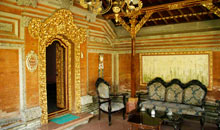
This is where Ubud's long tradition of homestays all began, right in the Royal Palace of the King of Ubud, more than 80 years ago, when Bali first started to attract bohemian artists from around the world. It is still going strong today, though prices have gone up. To rent one of the seven traditional stone bungalows in the sumptuous royal courtyard is still quite an experience, and every night this magical palace comes alive with the sound of Gamelan music as Balinese dances are performed just across the wall from this unique B&B.
• Jalan Raya, Ubud, +62 361 975057. Double room with breakfast from £40
2. Fibra Inn

The Fibra first opened 30 years ago, when Monkey Forest Road was not much more than a dirt track, and today it is still difficult to find a more friendly place to stay in Ubud. A rambling compound of traditional Balinese houses, the gardens are a riot of exotic flowers and tropical vegetation, while the swimming pool is small but utterly romantic. Owned by one of the island's most famous dancers, Sri, guests can can see her perform every Friday in the artist's hamlet of Peliatan, while on Sundays there are concerts of her own all-woman Gamelan orchestra. At the back of the hotel is an excellent spa.
• Monkey Forest Road, +62 361 975451, email: bagusfibra@yahoo.com. Double room with breakfast from £30
3. Jati Home Stay
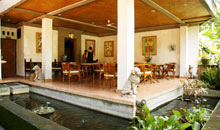
Parallel to the busy Monkey Forest Road, Hanoman Street is a lot quieter, and both sides are lined with budget homestay accommodation, hidden away inside traditional Balinese walled compounds. Fortunately Jati's homestay is well signposted as you weave left and right through a labyrinth of family temples, houses filled with noisy kids, artists studios, and an assortment of animals wandering around. Dewa Nyoman Jati is a well-known artist himself, and he opened his B&B 20 years ago to allow him to paint and also build up an important collection of works by contemporary Ubud artists, which is on show in his gallery. The accommodation is basic but comfortable.
• Hanoman Street, +62 361 977701. jatihs.com. Double room with breakfast from £12
4. Oka Wati Hotel
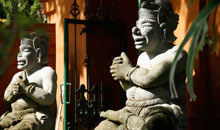
Oka Wati is a feisty Balinese lady, one of the pioneers of Ubud's homestays. When she first started taking guests in, her house was all alone in the middle of padi fields, and over the years, she has built up a comfortable nine-room hotel with swimming pool and restaurant. Once you've traversed the maze of narrow lanes that lead to the hotel, the location is perfect for exploring the centre of Ubud. Breakfast is copious, and in her restaurant Oka Wati still makes delicious gado-gado salad, a classic dish that strangely seems to be disappearing from restaurants here. She also serves the best Brem rice wine.
• Off Monkey Forest Road, +62 361 973386, okawatihotel.com. Double room with breakfast from £35
5. Warsi's House

Warsi has a tiny boutique specialising in Balinese textiles, right opposite Ubud's soccer pitch. You have to make your way through a chaotic passage filled with junk before coming out in an idyllic oasis where her four bungalows sit next to a holy temple and lotus-filled pond, looking out over a dreamy landscape of rice fields and coconut trees. Don't expect luxuries like a swimming pool or aircon, but the breakfast of banana pancakes is delicious, while Warsi and her nephew Nyoman are always on hand to spoil their guests.
• Monkey Forest Road, +62 361 975311. Double room with breakfast from £20
6. Rona
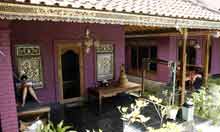
Located right at the entrance to Ubud, a walk down Tebesaya Road is like stepping back 10 or 15 years, when this was still a sleepy village. Rona is owned by an eccentric local known as Mr Chicken, who has turned traditional Balinese bungalows into a funky cafe, bookshop and hotel, decorated in very un-Balinese purple. Although there is an inviting pool, the rooms don't have aircon, though a fan is adequate considering the low-cost rates.
• 23 Tebesaya Road, +361 97322. Double room with breakfast from £18
7. Putu Putera Homestay
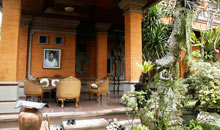
It is difficult to know just how much longer there will still be authentic homestays such as Putu Putera in Ubud, where for a minimal fee, guests can share the house of a local artisan, experience family life in a traditional compound, and learn directly from the craftman himself about the skills in painting, wood carving, stone masonry, dance or music that Ubud is so famous for. The owner here has converted the top floor of his house into five no-frills B&B rooms. His wife prepares breakfast, while guests are welcome to accompany him to his workshop where he creates wood and stone ornaments for gardens.
• 30 Tebesaya Road, +62 361 973204. Double room with breakfast from £6
8. Tiing Gading Bungalows
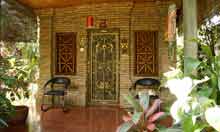
With no namesign, this is not the easiest place to find, but guests are rewarded by discovering a tranquil hideaway surrounded by thick bamboo groves, tall palm trees and a small river. The pool is to-die-for, and with a spa and restaurant it is easy to just relax here rather than going into Ubud in the evening. There are just 10 rooms, with aircon inside and cool terraces to sit out in the evening and enjoy an ice-cold Bintang beer.
• Tebesaya Road, +62 361 973228, vacationsinbali.com. Double room with breakfast from £30
9. Ubud Inn
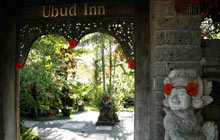
A host of chic boutique hotels have opened up on Ubud's main drag, Monkey Forest Road, but the trademark "tropical Bali" design is all pretty similar, and prices can be surprisingly expensive. The Ubud Inn was one of the first places to offer more luxurious accommodation, and although this may not be the hippest place to stay, it is difficult to find better value. There is a huge swimming pool, surrounded by lush jungle vegetation, bar, restaurant and spa, free Wi-Fi, while the spacious rooms come with a four-poster bed complete with mosquito nets.
• Monkey Forest Road, +62 361 975071, ubudinn.com. Double room with breakfast from £38.
10. Family Guest House
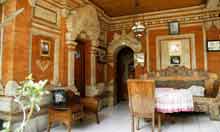
In the quiet artist's hamlet of Peliatan, this friendly homestay lives up to its name as the rambling compound is a great place for families to base themselves. The bungalows are simple and basic, but with large verandahs, and visitors are free to wander round the family temple and sumptuously decorated pavilions - just don't expect to find a swimming pool at this price. There is free WiFi, though, a copious breakfast famed for its brown bread, and just outside on the street is a fun "mini-bar", perfect for a late-night drink before going to bed.
• Jalan Sukma 39, +62 361 974054, email: familyhouse@telkom.net. Double Room with breakfast from £20.
• All photographs by John Brunton.
Source: Guardian.co,uk




 Conrad Bali is also in the Nusa Dua area and features four distinct wings that offer seclusion for MICE groups. There are seven hectares of manicured gardens and 360 guestrooms with the entry level being 45 sqm. The ballroom also seats 540 guests.
Conrad Bali is also in the Nusa Dua area and features four distinct wings that offer seclusion for MICE groups. There are seven hectares of manicured gardens and 360 guestrooms with the entry level being 45 sqm. The ballroom also seats 540 guests.















